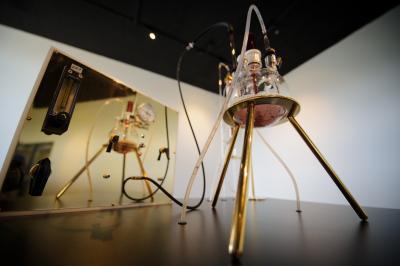A scientist and an artist have teamed up with a metal-tolerant bacterium called Cupriavidus metallidurans to produce gold nuggets in a glass bioreactor.
Using highly concentrated gold chloride, a natural toxin, the researchers grew the bacteria in an art installation called “The Great Work of the Metal Lover,” which is also a portable lab combining biotechnology, art, and alchemy.
“Microbial alchemy is what we’re doing—transforming gold from something that has no value into a solid, precious metal that’s valuable,” said biologist Kazem Kashefi at Michigan State University (MSU) in a press release.
The researchers were recreating a process they believe happens in nature, and discovered that C. metallidurans can withstand gold chloride concentrations at least 25 times stronger than previously realized, transforming the toxin into a gold nugget within about one week.
Included in the installation is a series of images made with a scanning electron microscope using ancient techniques by applying gold leaf to parts of the prints where bacterial alchemy had occurred.
MSU artist Adam Brown describes the process as “neo-alchemy,” and says art can help drive scientific inquiry.
“Every part, every detail of the project is a cross between modern microbiology and alchemy,” he explained in the release. “Science tries to explain the phenomenological world.”
It would be too expensive to make gold this way, but the experiment helps query the ethics of scientific engineering of nature.
“Art has the ability to probe and question the impact of science in the world, and ‘The Great Work of the Metal Lover’ speaks directly to the scientific preoccupation while trying to shape and bend biology to our will within the postbiological age,” Brown concluded.
The installation is on display at the cyber art competition, Prix Ars Electronica, in Austria until Oct. 7.
The Epoch Times publishes in 35 countries and in 19 languages. Subscribe to our e-newsletter.





